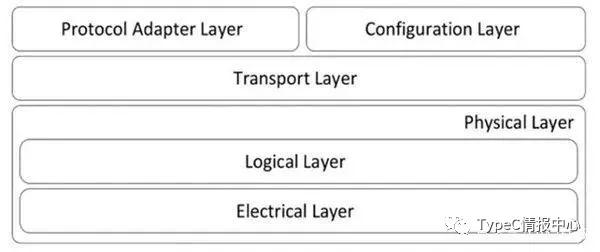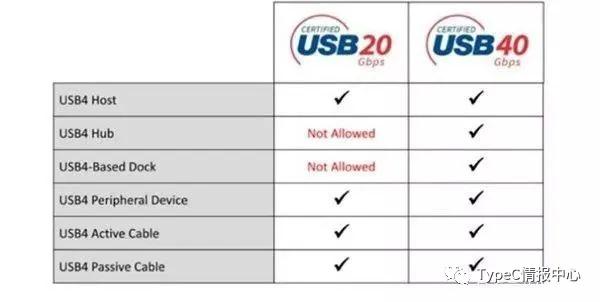
Upload time:2020-10-29| Authoradmin
The full name of USB4 is Universal Serial Bus Generation 4. The USB interface released the USB 1.0 specification in 1996, supporting low-speed 1.5 Mbps and full-speed 12 Mbps, and later released supporting speeds of 480 Mbps, 5Gbps, 10Gbps, 20Gbps, etc., and released the latest generation of USB4 specifications in September 2019. Supports 20 Gbps and 40 Gbps. For the evolution of the USB interface and the corresponding logo, please refer to Chart 1.
Three key points of USB4 new features
1. USB4 only uses the USB Type-C connector, and the USB4 signal adopts dual-channel transmission; while the past connectors such as USB Type-A or Micro-B only support single-channel transmission and cannot support USB4.
2. The fastest USB transmission speed supports 40G (20Gbps x2), and it can transmit DisplayPort video and audio at the same time. Designed to combine multiple protocols into a single physical interface, which can dynamically share the overall speed and performance of the USB4 architecture.
3. Backward compatible with USB 2.0 and USB 3.2 and support Thunderbolt 3.
USB4 connector and cable highlights
1. USB4 only uses USB Type-C connector.
2. USB4 Cable passive cable, the supported passive cable length is reduced from 1 meter for USB 3.2 Gen2 to 0.8 meter for USB4 Gen3.
3. If you need a longer cable, such as connecting a large screen or VR application, you can use an active cable. USB4 active cables are cables containing Repeater components (such as active components such as Re-timer and Re-driver), as well as optical fiber cables. As for the supported active cable length, the maximum length is 5 meters.
USB4 architecture highlights
The main components of USB4 are Router, Adapter, and TMU (Time Management Unit).
1. The router is a main building block of USB4. The router converts the tunnel protocol into USB4 packet transmission and uses TMU for time synchronization. It is mainly detected and managed by the built-in Connection Manager of the USB Host.
2. The adapter is built in the router, and its main function is the communication medium between the router and external components, and it performs protocol conversion. For example, the USB4 Host is transmitting USB3 data (as shown in Figure 2), and the internal USB3 Host uses the USB3 Adapter to encapsulate it into a USB4 Tunneled Packet. A router can support up to 64 adapters inside.
3. TMU is built in the router and uses a distributed time management unit (TMU) to synchronize time between routers.

USB4 distinguishes five levels by function
1. Protocol Adapter Layer: Responsible for the correspondence between USB4 and different protocols, and encapsulate the different protocols into Tunneled Packets, which are transmitted in the USB4 interface.
2. Configuration Layer: Responsible for processing the Control Packets sent by the Connection manager, and attaching the corresponding address in the path to ensure its reliable delivery mechanism.
3. Transport Layer: Define packet format, path, flow control and timing control, and generate link management Packets to provide time synchronization packets, flow control packets, etc.
4.Logical Layer: Responsible for establishing a USB4 connection between two devices, providing data transmission and reception, encoding and decoding, power management, error detection and recovery mechanisms, and communication through the Sideband Channel for channel initialization, including speed and Two-channel communication.
5. Electrical Layer: Define the characteristics of USB4 electrical signals, such as voltage, jitter, coding, etc.

As shown in Figure 4, taking USB3 Tunneling as an example, USB4 Host uses USB3 Protocol Adaptor to transfer USB3 Protocol to USB4 Hub Electrical Layer via USB4 Transport Layer, USB4 Logic Layer, USB4 Electrical Layer and USB4 Link. Then perform a series of USB3/USB4 conversion according to the sequence shown in Figure 4, and send the signal to the USB4 Device.
USB3 tunnel protocol
The USB4 signal consists of PCIe, USB3 and DisplayPort tunnel protocols. This section only explains the USB3 tunnel protocol. The USB3 tunneling protocol refers to encapsulating the original USB3 packet into a Tunneled packet through the Protocol Adapter Layer. From Figure 5, it is clear that the red part is the USB3 packet, and the blue part is the Tunneled packet. UFP (Upstream Facing Port) and DFP (Downstream Facing Port) will use Physical Layer transmission.

USB4 product type
1. USB4 Host: The product has more than one DFP and no UFP.
2. USB4 Hub: The product has a UFP and one or more DFPs.
3. USB4-Based Dock: The product has a UFP and one or more DFPs, and there are other component functions in the product, such as storage devices or network functions.
4. USB4 Device: The product has a UFP but no DFP.
Tunneling protocol supported by USB4
According to the specifications, there are different requirements for the tunnel protocol that Host/ Hub/Dock/Device must support. As shown in the figure below, "V" means that it must be supported, and the rest are optional.
For example, the USB Host must support USB3, DisplayPort and Host-to-Host Tunneling, but may not support PCI Express and TBT3 Tunneling.

USB4 supported transfer rate
USB4 supports the 20Gbps speed of USB4 Gen2 and the 40Gbps speed of USB4 Gen3. Does it declare that it must support these two speeds to support USB4? Intel announced the USB4 interface connector, divided into two versions
For USB4 Hub and USB4-Based Dock, it must support both 20Gbps and 40Gbps.
For USB4 Host and USB4 Device, it can only support 20Gbps. (40Gbps can be listed as additional support, non-essential support speed)

The transfer rate of USB4 is increased to 40 Gbps, and bandwidth can be dynamically shared. When using a USB Type-C cable, it can be compatible with Thunderbolt 3 and Display Port products on the market, which is a more convenient interface for consumers. But for product developers, USB4 is a relatively big challenge. In addition to the structural differences between product design and previous USB3 products, plus the attenuation of high-frequency signals on PCBs and connectors, more attention must be paid to high-frequency impedance. Match to ensure the quality of the transmitted signal during the development phase.
+86-755-23086166
+86-755-23590466
Office:Rm.428,building B3,MingYou Industrial products Exhibition&Procurement center,Baoyuan Road,Xixiang,Bao'an District,ShenZhen,China 518000
Factory: No. 18 Huizhi Road, Sanjiao Town, Zhongshan City